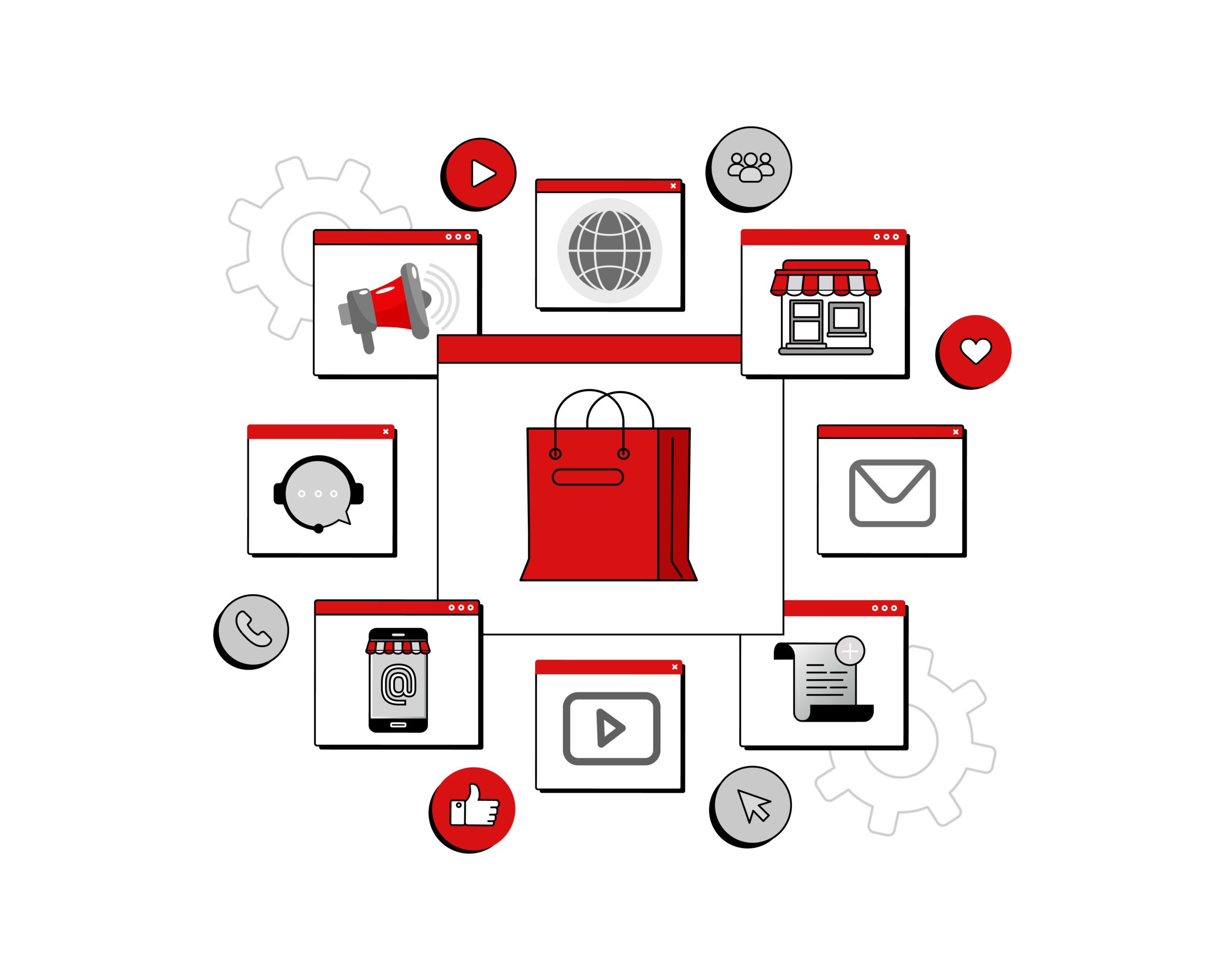In today’s world, enhancing shopping experience and understanding consumer demand is the key to stay on top the game. Depending on the situation, shopping experience must be fast and efficient sometimes, rich and experiential to others, and always accessible and intuitive. Consumers’ new expectations have emerged through COVID, which must be aligned with retail offerings and capabilities. Digitally enabled stores and a mix of physical and digital shopping journeys i.e. omnichannel approach are expected from brands and retailers. Additionally, customers want brands that are sustainable, environmentally friendly, and purpose-driven.
An Omnichannel approach is here to stay
Online and offline shopping are no longer separate experiences. Retail consumers now use online shopping, in-store shopping, and mobile apps interchangeably, preferring to do everything. In other words, they want the freedom to shop however they find most convenient at the moment. A few examples of this are buying in-store and having it shipped/delivered to your home, or buying online and picking up the items at the curb. As per IBM, 27% of overall retail consumers and 36% of Gen Z use omnichannel shopping to make purchases – more than any other generation.
In the minds of consumers, omnichannel shopping has become a way of life and is definitely the future of retail. Hence, retailers should design buying journeys that are easy for customers to follow, no matter what path they take. Although stores are no longer the default mode of shopping, they remain essential to the customer journey. However, the store experience will have to be streamlined and digitalized for many companies, and digital and in-store experiences need to be integrated.
Sustainability is the key
COVID-19 has shifted consumer perspectives on sustainability. Consumers of all ages today look to brands and retailers for ways to shop sustainably. Numerous studies have demonstrated that consumers are aware of the current environmental crisis.
Retailers and brands can consider this as an opportunity to create more profitable relationships with customers. Digitally savvy consumers of today are aware and focused on finding brands that align with their values related to sustainability. Businesses will need to raise the bar to pass muster since consumers are demanding more across the board. As well as allowing consumers to live their values through the products they buy, companies need to ensure that the products are sourced, manufactured, and delivered according to the customers’ values. The millennial generation is leading the charge, but every age group indicates that sustainability, the environment, and/or personal wellness are factors when choosing brands. Consumers acknowledge that sustainability and wellness are intertwined and they are even willing to pay a premium for products that meet their priorities.
Consumers are willing to pay more for the following attributes: non-toxic products, greater health benefits, organic ingredients, and environmental responsibility. Moreover, it’s not just the wealthy who say they’re willing to spend more, in fact, retail consumers, regardless of their income level or age group, are interested in supporting sustainability and health. IBV research shows that almost 3 of 4 (72%) food companies are working to eliminate hunger, 68% of personal care companies are enhancing health and wellbeing, and 63% of apparel and footwear brands are tackling climate change. To say it all, developing a back-end sustainability strategy that is connected to the customer experience is the future of retail and is crucial to a company’s long-term sustainability.
Customers are purpose-driven
Traditionally, cost, convenience, and value drove shopping behaviour, but the pandemic changed this paradigm. Today, purpose-driven consumers are the largest segment of global consumers, choosing products based on their alignment with their values. The purpose-driven consumer is willing to pay more for products and services aligned with their values and change their buying habits to reduce environmental impact. Consumers who buy for a purpose are also more engaged, shopping more frequently than those who buy for value, which makes them attractive to retailers and brands.
Purpose-driven customers often introduce their friends and family to new products and brands more often than value-based consumers. Hence, brands must align their business practices with the values of purpose-driven consumers so as to gain the trust of these consumers, from product development and design to after-sale support. For instance, as recycling is a large part of daily routine, brands should embrace the circular economy and retailers should empower purpose-driven retail consumers by offering resale, reuse, and recycling options. A brand’s or retailer’s extra effort to connect with purpose-driven consumers could be well worth it. Companies that make shopping simpler for these consumers are rewarded in terms of more sales and profits.
Trends of Retailing 2023
Brands that streamline the shopping experience and provide product clarity by using AI and intelligent workflows to deliver the right message to the right customer at the right time will have a great opportunity to win over retail consumers. Here are some of the common trends of retailing to look for in the year 2023:
Streamlined hybrid shopping
As consumer retailing demands digitally-enabled stores, retailers are adapting to meet their needs. Integrated digital and physical operating platforms enable companies to deliver experiences that maximise the strengths of each channel.
Shift with your shoppers
Be prepared to make changes in real-time as customers’ needs change and identify which digital and in-store touchpoints are most important to them. Data platforms are required that can collect and analyse information from internal and external sources to enable retailers to take necessary steps.
Upgrade the experience
Make your stores feel special to retail consumers by investing in the areas that keep them coming back again and again. By customising each store to the needs of the local community, the shopping experience can also be made more personalised.
Elevate store associates
In the changing world of retail, store associates still play a vital role. Besides stocking shelves and ringing up sales, they can also serve as a source of information, support, and engagement for customers. There is a unique opportunity for brick-and-mortar retailers to differentiate from their online competitors through their store associates.
Establish clear standards
Consumers can make more confident purchases with standardised, easy-to-use product information verified by reputable parties. However, transparency does not just come from tracing a product’s source materials and highlighting its environmental impact, but this information is only valuable if consumers can understand it and compare it with other brands.
Make sustainable shopping easier
Translate technical terms into language consumers can understand, and inform them about tradeoffs between price, service, and environmental impact, so they can make their own decisions easily and conveniently.
Appeal to personal preferences
Consumers are looking for ways to improve their lives as well as protect the environment. Brands can make sustainable choices more appealing by emphasising the health and wellness benefits of their products. “Good for the planet, good for me” can be the USP of the products.
Go beyond the product
Many consumers are looking for ways to align their purchases with their values. Make it easier for customers to understand how a product supports sustainability, including how fulfilment, transportation, and packaging impact the environment. Basically, the key to influencing retail consumer behaviour and purchasing decisions is clearly communicating what makes a product sustainable.
Become an open book
Retailers and brands need to adapt to the purpose-driven consumer, aligning every aspect of their brand with their values. The key here is to create propositions that go beyond price, selection, and convenience. The purpose-driven consumer expects brands to be clear, honest, credible, and open about their offerings. The purpose-driven consumer is also prepared to engage with brands, so be prepared for dialogues, which will lead to powerful ambassadors who will spread the word about your brand.
Know your customers’
Retailers and brands need to identify what their customers want and find authentic ways to fulfil their needs. In order to stay relevant, they may have to change their entire operating models-and those who fail to adapt risk being left behind.
Conclusion:
When choosing where to shop and what to buy, consumers are looking for retailers and brands that reflect their own values, such as sustainability, health, and social responsibility. Comparing options quickly—using trusted insights—and making a confident decision is of paramount importance to them. To align their products with their customers’ preferences and values, brands need to understand their customer base’s mix of purpose-driven and value-driven consumers. Moreover, they must integrate their stores into omnichannel shopping journeys in an elegant way, catering to the needs of a new generation of shoppers.
About YRC Consultants
The retail consumer behaviour is continuously changing. They use a mix of digital and in-person channels, hence it becomes essential for companies to get in touch with retail strategy consultants and experienced retail consultancy like YRC who can guide them at every step. YRC provides a wide range of services in the retail and eCommerce industries, which can help our clients offer seamless experiences to their consumers. If you want to know more about consumer retailing and trends of retailing, get in touch with YRC retail management consultants today.
Get In Touch











